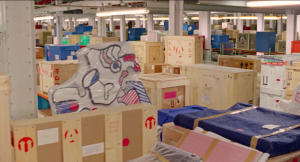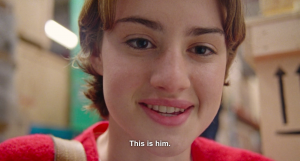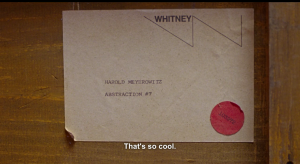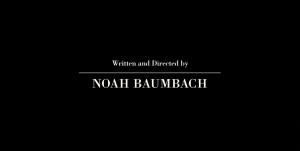The value and function of objects are not fixed. As time passes, objects circulate in space, degrade, get lost, become obsolete, stagnate in forgotten boxes, end up in a landfill, in a museum or in the Richler’s room… Today, I am looking at three objects I found on Richler’s desk, a match box, a cigar and an obsolete half franc coin and attempt to map the intersection between value, circulation, context and function. The peculiarity of those objects lies in the fact that the performances of their (original/utilitarian) functions entail their losses and/or their slow or immediate degradation. That is to say, if I smoke the cigar, it disappears into smoke; if I light a match, I must throw it out after; if I use the coin, I must exchange it for a commodity. Due to their ephemeral and low exchange value, those objects often escape the logic of commodification. For example, in the world of smokers, cigarettes (less applicable to cigar) are given and taken all the time, among strangers, free of charge. Coins also circulate, out of benevolence, among strangers. Same goes with lighters. They circulate in a mysterious way, constantly appearing and disappearing. There are either 0 or, suddenly, 7 lighters in the environment of the established smoker. I am suggesting here that as long as those objects are not performing their utilitarian functions, they have no definite owner. In the end, the one who owns (exert control over) the cigarette/cigar, lighter/match or coin is not necessarily the one who bought (or earned) it, but the one who ends up using it. However, once those highly shareable and mundane objects get removed from daily circulation and enter the institutional context that is the Richler’s Reading Room, a whole other logic applies in defining their functions and values.
In the article “Lost Museum,” Lubar et al. mention that “objects still in museums can be lost” and once “objects [are] separated from the information about them — their stories, their metadata — [they] lose much of their value” (2). In the context of the Richler’s Reading Room, those three objects derive value from their history and maintain their values by not performing their original functions. If I would light the cigar (something that has crossed my mind before) its value would be lost because it wouldn’t be Richer’s anymore (as we suppose it is). This logic does not necessarily apply to his chair for example, as it can perform its original function, to support someone, without compromising its association with Richler. The value of the cigar no longer reside in its potential smokability. In fact, from the way it is preserved (or rather, not preserved), the tobacco has dried up and it would most likely hurt the throat to smoke the cigar. Nevertheless, it still has more value than a fresh cigar because it performs its new defined function: to recreate Richler’s aura. The value that those three objects gain from performing this function is not definitive as it depends on the ever-changing cultural context. This function (of recreating Richler’s aura) remains legitimate as long as the value of Richler, as a writer, is maintained. Non-useable objects must relate to a larger history and people working in cultural institutions must make the history to which objects relate to significant. It is an on-going and dynamic process. In the essay “Contingencies of Values,” Smith explains how objects maintain and increase their values by circulating:
“An object or artifact that performs certain desired/able functions particularly well at a given time for some community of subjects, being perhaps not only “fit” but exemplary-that is, “the best of its kind”-under those conditions, will have an immediate survival advantage; […] it will not only be better protected from physical deterioration but will also be more frequently used or widely exhibited and, if it is a text or verbal artifact, more frequently read or recited, copied or reprinted, translated, imitated, cited, and commented upon- in short, culturally re-produced-and thus will be more readily available to perform those or other functions for other subjects at a subsequent time” (1814).
It is not only the objects that gain value by being related to Richer. Richler reciprocally gains value from having his objects inside the institutional context. But the questions is, how long are we going to care about a cigar that will never be smoked or about a coin that cannot be exchange for a commodity? Those objects will, at some point, be removed or thrown out but not now- in 2017, at Concordia. Within this context, Richler is a significant literary figure. Such a room allows the name of Mordecai Richler “not merely to survive within but to shape and create the culture in which its value is produced and transmitted and, for that very reason, to perpetuate the conditions of its own flourishing. Nothing endures like endurance” (Smith 1815).
Lubar et al. quotes Michael Mares, former director of the Nebraska States Museum. Mares claims: “It is the moral obligation of administrators to maintain their museums at whatever cost … . Museums are forever, and no one ever said that the road to ‘Forever’ would be easy’” (1). Some museums, as described in the article, will go great length to preserve objects even if they are unlikely to ever be used, In this case, what is preserved is not the physical object but rather the historical status quo of valuable art. Noah Baumbach’s latest movie “The Meyerowitz Stories” illustrates the value artifacts gains by entering institutions. The story presents Harold Meyerowitz, a sculptor who dwells on his past and ephemeral success and who struggles to gain recognition at the end of his life. The Whitney museum bought one of his pieces and seems to have lost it. The last scene of the movie shows his granddaughter walking in the Whitney’s ‘deep storage,’ finding the box which contains the piece.
The fact that we don’t see the sculpture is significant because it implies that the object is of secondary importance. What is significant and makes his granddaughter proud is that the piece is inside the prestigious cultural institution that is the Whitney Museum.
Works Cited
Lubar, Steven, et al. “Lost Museum.” Museum History Journal. 10, 1, 2017, pp. 1-14.
Smith, Barbara Herrstein. “From Contingencies of Value.” The Norton Anthology of Theory and Criticism. Edited by Vincent B .Leitch. W. W. Norton & Company, Inc. 2010. 1798-1818.
The Meyerowitz Stories. Directed by Noah Baumbach, performance by Adam Sandler, Grace Van Patten, Dusting Hoffman. 2017. Netflix.





